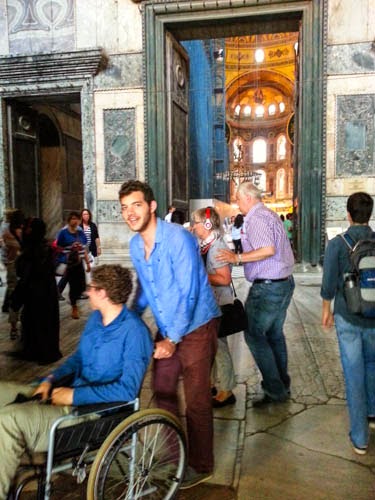 |
| Waiting patiently |
9am sharp, we were scheduled to be picked up for a day of official sight-seeing. We waited outside the apartment:
Sulamon, our guide, is a charming Turk from Antolya. He was a reservoir of vast amounts of information about Istanbul through the ages....and in this city that's a lot of ages. Our agenda - Topkapi Palace, Hagia Sophia (former church turned mosque turned museum), Blue Mosque, Grand Bazar, and Basilica cistern. Sulamon was quick to point out that it was virtually impossible to see all this in a single day, but I told him that we planed to explore in depth on our own, and this day was just an introduction and orientation. Off to Topkapi Palace.

Home to 400 years worth of Sultans, the palace is a huge collection of buildings housing all aspects of Sultan-like life, including exhibits portraying the Sultan's clothes, thrones, jewels, entertainment, harem etc. The largest jewel of the Ottoman empire is on exhibit weighing in at 82 carats. Known as the spoon-maker's diamond, legend has it that it was found in a heap of garbage and purchased for four spoons.
Here is one of the Sultan's robes. From the look of it, the Sultan must have been about 5 feet tall. One of the other robes is HUGE, so I guess they came in all shapes and sizes.
After Topkapi, we moved on to the Blue Mosque, built by Sultan Ahmed the 1st. He built it to appease the gods after losing the Persian War. As a matter of fact, it was the first mosque in the Ottoman empire to be built with money from the empire treasury, rather than war spoils. It's a working mosque, so shoes must be removed to enter, shorts are not permitted and women have to have their hair and shoulders covered. They hand out drapes to cover whatever part of you needs to be covered. Here is a photo taken inside the mosque. It's pretty impressive:
Keeping our breakneck pace we crossed the square to the Hagia-Sofia. Sulemon took pity on Sam and found a wheelchair for him.
Hagia-Sofia is an impressive orthodox church converted to a mosque before becoming a museum. It's filled with covered-up (plastered-over) murals and statues as well as deconstructed crosses. Interesting.
Our itinerary included a visit to one of the many underground cisterns in Istanbul, constructed during the Bizantium to hold water brought in by the Roman Aqueducts. The largest, most famous one (pictured here) is known as the Basilica Cistern:
These things are all over the city and are now used as museums and function rooms (people get married in them). On Sulemon's advise, we went to a smaller one without the crowds. They served us tea as we sat and admired the size and scope of this smaller cistern.
Sulamon dropped us off at our apartment and we went out in search of street food. We found it on the span of the Galata Bridge. The street food in Istanbul is plentiful, fresh and delicious. We chose a guy serving kafta sandwiches from his cart. YUM!!




No comments:
Post a Comment